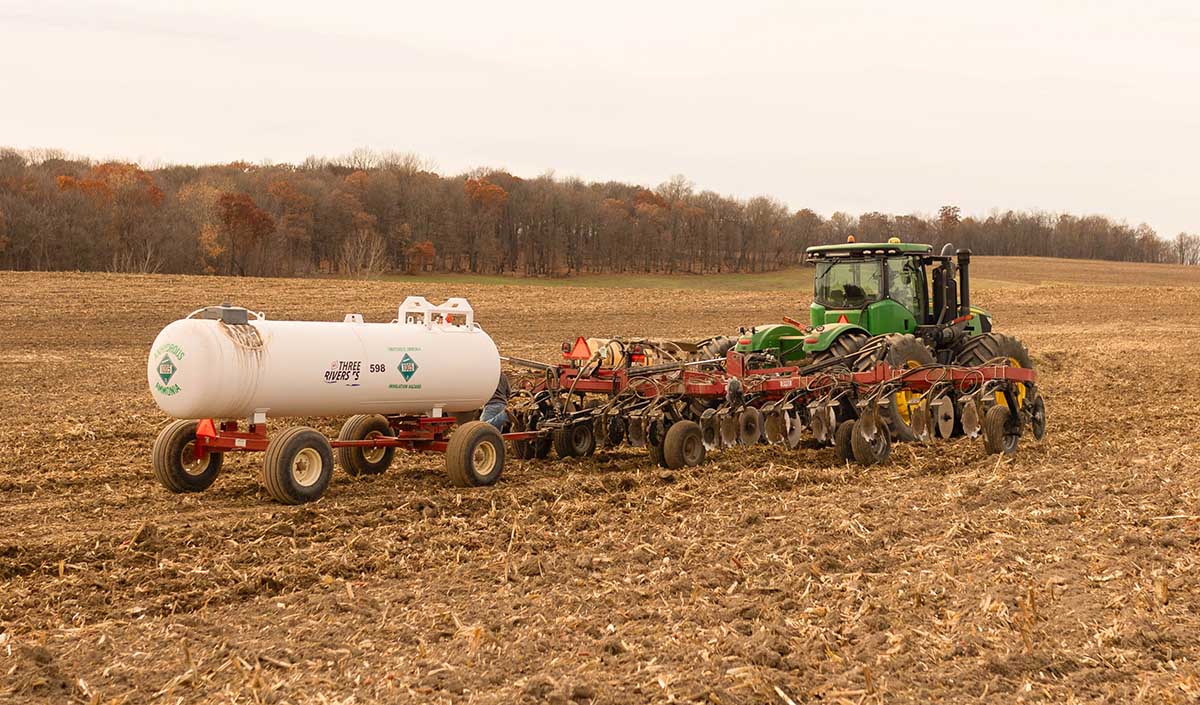
(Photo: Iowa Soybean Association / Joclyn Kuboushek)
Walking Rows: Wait until the soil temp is 50 degrees or lower
October 9, 2025 | Kriss Nelson
As farmers head toward harvest completion, Iowa Soybean Association (ISA) research agronomists urge farmers to wait until soil temperatures are 50 degrees or lower and dropping before applying their fall anhydrous. Review soil temperatures in your area by viewing the Iowa 4-inch soil temperature map.
Now’s the time to take part in on-farm research. There’s still room to join a fall trial or make plans for spring. Current trial opportunities span fertility to conservation, each aimed at helping farmers get more return on investment.
Alex Schaffer - Central/South Central Iowa
Harvest is well underway in central and southern Iowa. Many farmers took advantage of the late stretch of warm, dry weather to harvest their soybeans. Mostly, I've heard about pleasant surprises in soybean yields.
While August and September finished a bit dry overall, soybeans had enough late-season moisture to fill the pods. I have heard that soybeans on the early side of 3.0 maturity did better than longer maturing soybeans in central Iowa. I attribute this to the dry finish to summer failing to completely fill out the fuller-season soybeans, and I would recommend that a farmer spread their risk across a few different maturities suited to their area, because it is impossible to predict how the season will go.

As farmers are out harvesting and thinking about the next job, we are completing our plans for fall-implemented trials for the 2026 cropping season. We are looking at about seven different fall-implemented trials covering topics such as conservation, fertility and crop management. These trials will directly tie farmers’ results to return on investment.
With input prices being upside down with commodity prices right now, our slate of trials for the 2026 crop year is hyper-focused on fine-tuning inputs and cropping systems to focus on the basics of what pays and what doesn't. It is important for farmers to focus on the cost of production in this environment.
As farmers are making rounds in the field, I know they are thinking about fall fertilizer applications. I would encourage farmers to keep in mind the fall anhydrous best management practices outlined here. Ammonia season is right around the corner, but not yet. Wait until soils reach 50 degrees and falling.
Shane Beck – Northeast/Northern Iowa
Harvest is progressing nicely. The rain on Monday may have slowed things down a little, but hopefully it also cuts down on some of the dust we have seen.
Fields with large amounts of sudden death syndrome (SDS) also saw the largest yield hits this year. Even fields treated with seed treatments still experienced a fair amount of SDS this year. This disease is established in the early spring when it is cool and wet. To help manage this, it is important to use seed treatments and look for varieties that rate well for defense against SDS.

I have also received some calls on green soybean plants in fields with no pods on them. What are those plants? They are male-sterile plants, which means they produce no pollen and cannot self-pollinate. There may be a few pods on those plants where an insect or animal cross-pollinated the plant with pollen from another soybean plant. The environment causes male sterility. This can be through differences in temperature at different growth stages or by applying a herbicide at a specific time. There is really nothing that can be done to prevent it if the conditions are right for it to occur. Some varieties are more prone to male sterility than others.
Yield reports have been average to above average so far on both corn and soybeans. I have heard of 60 to 80 bushels to the acre for soybeans and 200 to 250 bushels per acre for corn. Southern rust was a driving factor in corn yields this year. Fungicide applications appear to have been necessary, and in some cases, two applications of fungicide on the corn were the big driver behind yield.
We still have some open trials this fall. If you would like to discuss potential research opportunities, feel free to reach out to me.
Craig Woods – Northwest Iowa
Harvest is still moving along steadily despite minor breaks caused by the rain, which was welcome. Most farmers are finishing up or have finished harvesting their soybeans and are looking to have a strong push for harvesting corn.
While most farmers have been relatively happy with their average yields of 60 to 70 bushels per acre, in-field soybean variability was high this year.
Corn yields ranging from 200 to 240 bushels per acre have been highly variable depending on possible wind and hail damage from earlier in the season or disease stress from a season dominated by southern corn rust.

Dry down has been a key factor and concern for harvest with low moisture percentages in both corn and soy. Some soybeans have been coming out of the field with moisture levels below 10%. From concerns about possible combine fires to losses of yield due to shatter or ear drop, this latest rain, with promises of moisture on the wind and cooler weather, is a welcome change.
Since weather conditions still allow soil temperatures to hold around 60 degrees, optimal conditions for applying nitrogen-containing fertilizers might not be reached for a while. Fifty degrees and trending lower is the suggested soil temperature to help retain nitrogen in the field and reduce leaching caused by the applied fertilizer, which has a higher ratio of water-soluble nitrate to ammonium before plants can begin uptake. While nitrogen stabilizers are an option for maintaining applied fertility, they have a limited lifespan before they break down.
Lucas De Bruin - Southeast/Eastern Iowa
Harvest is still in full swing and there are a lot of soybeans and corn that have come out. Some recent rains have slowed progress, but not for very long. I've seen a few grain piles get started. With concerns about storms last week, many farmers shifted their focus to corn harvest. They were hoping to harvest their corn to avoid potential storm damage and hoping some rain would add moisture back into their soybeans.
Soybean yields have been good to slightly above average, while corn yields keep rolling in below what many wanted. Fungicide definitely had a positive impact this year.

A lot of cover crops have been planted and they are growing. Even the earlier harvested fields that don't get cover crops have a nice green stand of volunteer plants. That serves as a friendly reminder to get out and check your combine settings as you progress through the fall.
Looking at the forecast, this might be a good year to do some fall herbicide spraying if you have the ability. Starting clean in the spring is a lot easier to keep clean all year long.
We are prepping for our fall trials. Two of the trials focus on nitrogen rates and products. If you are interested in learning more about your farm's nitrogen use efficiency numbers, visit here or contact an ISA research agronomist.
Gathered by Kriss Nelson.
Back